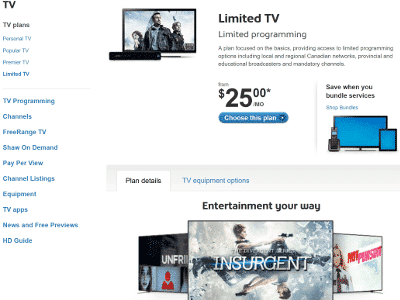
 Two weeks ahead of a March 1 deadline for cable companies to offer a $25 “skinny basic” cable TV package, as mandated by the CRTC a year ago, Shaw looks to be the first to soft launch its offering, which it has dubbed Limited TV.
Two weeks ahead of a March 1 deadline for cable companies to offer a $25 “skinny basic” cable TV package, as mandated by the CRTC a year ago, Shaw looks to be the first to soft launch its offering, which it has dubbed Limited TV.
Meanwhile in Saskatchewan, SaskTel is offering its $25 package called Lite maxTV, which can be customized by adding a $14.99 Sports pack, a $5.99 Entertainment pack, a $5.99 Information pack, and/or a $5.99 Music pack.
In Ontario, VMedia is heralding its “skinny” basic package, which appears to be Internet Protocol Television (IPTV).
Several American stations are included in Shaw’s package, namely CBS, ABC, Fox, NBC and PBS, basically the same ones that have been included with “basic cable” since before the age of the remote control.
A commenter on Shaw’s community forums page offered an opinion of Limited TV saying, “I just got off of a chat with a sales rep. The Limited TV package is available now. not much of a deal, more of a deterrent.”
The CRTC sent out a reminder on Wednesday “of the new requirements to offer and promote a small entry-level basic service and flexible packaging options coming into force on 1 March 2016.”
“Part of the reason we mandated this change was to make television services more affordable,” said CRTC chairman Jean-Pierre Blais the other day in a speech at the Canadian Club in Toronto, a gathering sponsored by Rogers, a fact that didn’t go unremarked upon by Blais. “Part was to underscore the role of local content in the television system. And part was to re-emphasize the social duty of broadcasters to provide such an important public service.”
But how a $25 package will fly with consumers that doesn’t seem to offer significantly better choice than a digital over-the-air antenna remains to be seen.
Even by naming their package “Limited TV”, Shaw is typical among cable providers in letting the public know its exact attitude to being forced by the government to offer a basic TV package.
“Change is being introduced in a responsible and measured way to ensure the television industry has time to adjust,” said Blais. “Some have responded favourably. Pick and pay, for example, has already caught on as a service delivery model among some service providers. Others have dug in their heels. They warn of red ink and job cuts. They are trying to create wedges and change public policy well after the proverbial horse has left the barn.”
“Skinny basic” is an attempt to at least provide an affordable option for “cord cutters” or people who are fine watching whatever content they can online.
Which is fine for people who have no interest whatsoever in live sports, which helps to explain the legions of people online who boast that they would “cut the cord tomorrow” if a reliable streaming option for live sports existed.
“The old way of doing business — of squeezing every last drop of profit out of simultaneous substitution and rented, made-in-America content — is no longer sustainable. Truly great content is what draws viewers. Those that make that content will thrive.” – CRTC chairman Jean-Pierre Blais
With most cable companies’ basic cable packages running about $40 per month, plus $7.95 HD set-top box rental, one wonders if the CRTC’s attempt to provide an inexpensive minimum service won’t end up costing Canadians the same amount or more than previously existing bundles.
Shaw’s $25 package bundles together “up to” 44 channels, and requires a set-top box, $5 per month to rent or $138 to purchase outright, or $10 per month if you want an HD PVR.
Add the cheapest theme bundle to the “skinny basic” plan, and you’re already roughly as expensive as Shaw’s previously least expensive option, called Personal TV.
Rogers is simply telling customers making enquiries about their “skinny basic” package to check back with them in March.
Bell will apparently be unveiling its package on February 21.
The second phase of the CRTC’s instructions to cable companies, known informally as “pick and pay” or formally as “flexible packaging options, will be required to be offered as of December 1.
The “skinny basic” packages arrive from the cable companies with all the enthusiasm of late homework turned in by a student who knows that his teacher is furious and is likely to stamp the student’s work with F from now to the end of the year.
Referring to the latest round of the CRTC’s Let’s Talk TV listening tour, Jean-Pierre Blais had nothing kind to say about Canada’s telco executives.
“We recently wrapped up a two-week hearing on local and community television,” said Blais at the Canadian Club. “I listened as Canadians spoke with intelligence and passion to many of the issues I just described, while corporate executives who own luxury yachts and private helicopters came looking for subsidies.”
Considering that the rationale for the death of television as we know it is that viewers would like more choice for less cost, it must be discouraging to watch the telcos pushing in the opposite direction.
Blais’ vision for media in Canada and the CRTC’s role is bold, telling his audience the other day that Canadians “approve of responsive, forward-looking regulations that strip away old entitlements and foster a dynamic marketplace that rewards intelligence, creativity and daring.”
As Canadian media begins to fold in on itself, with the threatened shuttering of local TV news departments across Canada in full swing, Canadians are going to need that sort of bold rhetoric, the feeling that they have an ally during an era of technology-driven change.
Left to market forces, Canadian media would quickly lose its independent news media and original programming sectors. But to say that these changes are a result of government regulation is to present a false choice to Canadians.
“Corporate executives cannot bury their heads in the sand and pretend that change isn’t happening,” says Blais. “They must rise up and meet the challenge of a new content era head on. The old way of doing business—of squeezing every last drop of profit out of simultaneous substitution and rented, made-in-America content—is no longer sustainable. Truly great content is what draws viewers. Those that make that content will thrive.”
By trusting the voice of Canadians and ignoring the fear mongering of both telco executives who warn of billions of dollars in lost revenue to their bottom line and of union representatives who warn that “pick and pay” will result in massive job losses, Blais is striking the right balance.
Watch Blais’ remarks here.
Comment
One thought on “Will skinny basic cable make a difference to your bill?”
Leave a Reply
You must be logged in to post a comment.





 Share
Share Tweet
Tweet Share
Share




I’m the guy who posted the “deterrent comment”. I am in Sault Ste. Marie, ON, where we have no decent options for OTA transmission. No CBC, TVO, only CTV and it is a pretty poor signal. The CRTC should be addressing this issue. In our community, we are only able to pay extra for the public broadcasting stations through a private provider. I really miss the days of rabbit ears. Why not look at multi-casting as a solution for OTA? Do I need to keep supporting telco execs and their yaughts, to get access to public television? Aren’t my tax dollars being used to fund public media broadcasting? Why am I paying twice?